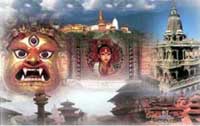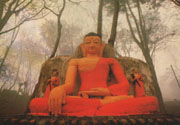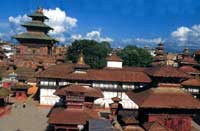Pilgrimage Tour - Kathmandu
Located just opposite the famous Gaddi Baithak in the eastern part of Kathmandu Durbar Square, the complex of Kumari Baha also house of the goddess Kumari the Royal deity. The Baha or Vihar consists of a three-storyed structure built round an enclosed courtyard and the main entrance is guarded by two huge stone lions. The external facade and inside façade facing the courtyards are embellished with the exquisite wood carved windows and doors.
The main shrine is directly opposite to the entrance and there is a stupa / Chaitya in the courtyard. Asidefrom serving as a Vihar, this is primarily the shrine of the living goddess 'Kumari' a Buddhist girl chosen and worshipped as an incarnation of Hindu mother deity.
 Kwa- Baha:
Kwa- Baha:
This is situated in the northern part & Kathmandu in Tha-hiti a few minutes walk from the famous Thamel locality. The shrine is a three-storyed building surmounted by a small cuppola. An artistically decorated by wooden frames, the door of the main entrance is flanked by the images of Sariputra and Mandgalyana two principal attendants of Lord Buddha. Inside the courtyard are an 'Aahokan Chaitya' a stupa structure of earlier period and a common small Chaitya on a pillar. The steps leading to the main shrine are flanked by two metal lions.
Musya Baha:
Located in Jyatha adjacent to Tha-hiti, this Baha is one of the few typical Baha structures left intact. The entire building is of two storeys. The main deity (Kwapa-dyo) is an image of Aksobhya facing north and the main door of the shrine is guarded by two stone lions. Wooden carved struts supports the entire tiled roof structure.
Dhwaka Baha:
A few minutes walk down the road from Masya Baha is Dhwakabaha is a auspicious courtyard with the shrine of the main deity ‘Asobhya located in the south-east corner facing north. Although the Vihar has not been able to retain its original structure due to the severe damage in the great earthquake of 1934, there are three stupas of which two stupas date back to Licchavi period- testifying antiquity of the place. Historians have ascribed the origin of the Vihar to not later than 7th century A.D.
Chusya Baha:
Located in Jyatha Tole, a few minutes walk down the road from Musya Baha, Chusya Baha, probably is the finest example of Baha architectures. Directly opposite the entrance is the shrine of Akshobhua- the Kwapadya, facing north. The entrance is flanked by two elephants. One of the most striking features of the Baha is the series of beautifully carved struts supporting the courtyard. As the struts are ascribed to the fourteenth century A.D., it is believed the origin of the monastery could be dated even earlier.
Itum Baha:
Situated a little west of Kilagal Tole, Itum Baha is one of the largest and oldest of Vihar complexes. It is a large, rectangular courtyard and surrounded on three sides by residential buildings. Although three other subsidiary Vihars adjacent to the main courtyard comprise the Vihar complex, the main shrine is located in second subsidiary courtyard. Over the entryway to this courtyard is and exquisitely carved wooden torana depicting an episode from Lord Gautam Buddha’s life and is believed to belong sixteenth century A.D. or even earlier period. The main deity or the Kwapa dyo is an image of Aksobhya facing east of the main entrance. The Baha shrine is marked by a metal lions flanked large temple bells. In the centre of the courtyard is an Chaitya (Stupa) and to the east of this a stylized stupa with large Buddha figures believed to be dated between eleventh or twelfth century.
 Yatkha Baha:
Yatkha Baha:
A few minute’s walks from Itum Baha is another Baha in the Yatkha Tole. Although it doesn’t bear any common features of a typical monastery any more, this Baha is noted for a large stupa, in the centre of the large stupa, in the centre of the large courtyard- surrounded by residential houses. The main shrine building is of recent renovation. However, the wooden 'Torana' is of unusual depiction of seven Buddhas and probably dates back to twelfth century A.D. The central stupa is a reminiscent of the famous ‘Swoyambhunath Stupa.
Te Baha:
A famous courtyard or a locality in Kathmandu is located in the eastern end of New road. Although the salient features of a typical Baha is virtually missing it is assumed the compound comprises two Bahas in medieval times. One of the main shrines 'Kwapa dyo' is situated among the buildings along the western side the second 'Kwapadyo' is located in the centre. The compound is more renowned because of other religious shrines and historic stupas existing here. Among others, within the complex are the house of a deity called 'sankata' the shrine of 'Bhadrakali' Chen (or the residence) two highly popular Shankata deities of the Kathmandu valley. In addition, the open area also houses several Licchavi period stupas chaityas. Historians attribute this area as of high historic importance and ascribe the origin to 5th century A.D.
Jana Baha:
Located in Kel Tole, this Baha is one of the most famous of all Bahas of Kathmandu. Hundreds of devotees throng to this places since early morning to early afternoon. Also every evening, religious prayers are sung at the main entrance of the courtyard at the main entrance of the courtyard at the tunes of traditional devotional music. Culturally, this Baha is most well known as the home of White- Matshyendranath or Jana Baha dyo or Karunamaya –the compassionate one. Although, the Baha doesn't possess a typical Baha architecture (Original structure destroyed in 1917 fire), the importance of the courtyard is enhanced by the shrine of Jana Baha dyo. The shrine is a two storyed whole façade of the temple is decorated with a great array of Buddhist figures and each of the three doorways has a repousse torana / tympanum.
Directly infront of the main door of the shrine is a small chaitya known as Knak Chaitya (Presently a shape of white dome). In addition, the courtyard is filled with an array of stone images and thirty-one Votive stupas.
Sigha Baha:
Situated in the Naghal Tole, few minutes walk from Thamel is a Sigha Baha also knownas Kathe-Swoyambhu a large courtyard with a huge stupa reminiscent of the great Swayambhunath. The dome of the stupa rests on white washed pedestal. Above the dome or Garbha is a four sided harmika with all seeing eyes similar to those at Swayambhu. In the courtyard around the main stupa are a number of votive chaityas, shrines including mother Harati and deities from Mahayan pantheon. Offer important feature is a stone standing Padmpani assigned to the ninth century A.D.
 Syangu Baha:
Syangu Baha:
The local Buddhist community of Kathmandu refer the famous swoyambhunath shrines as Syangu dyo- and it is assumed there existed a Buddihist Baha in the olden times, However, the whole complex is dominated by the all famous "Swoyambhu Mahachaitya the huge white dome towered by harmika in each cardinal.
Tham Baha:
Also known as Bhagwan Baha, Tham Baha is one of the best preserved complex of its kind. Located in the northern part of old Kathmandu township the famous area of Thamel drives its name from Tham Bahi. The Bahi/ monastery is only a stone’s throw from the main bazaar of Thamel. The main shrine is located through an entryway, which opens to the courtyard proper. The main shrine is directly opposite the entrance and is of three storeys with a large cuppola. The shrine is flanked by two mythical creatures Sardulas and lions. The main deity of the shrine is an image of Simha Sartha Bahu a legendary hero/ trader of ancient Kathmandu. The complex is typical with a two storied building with open halls on ground floor and lattice covered, overhanging balconies above.
SUI-REN Travel Pvt. Ltd. of Nepal
"The Very Best in Travel Services"



